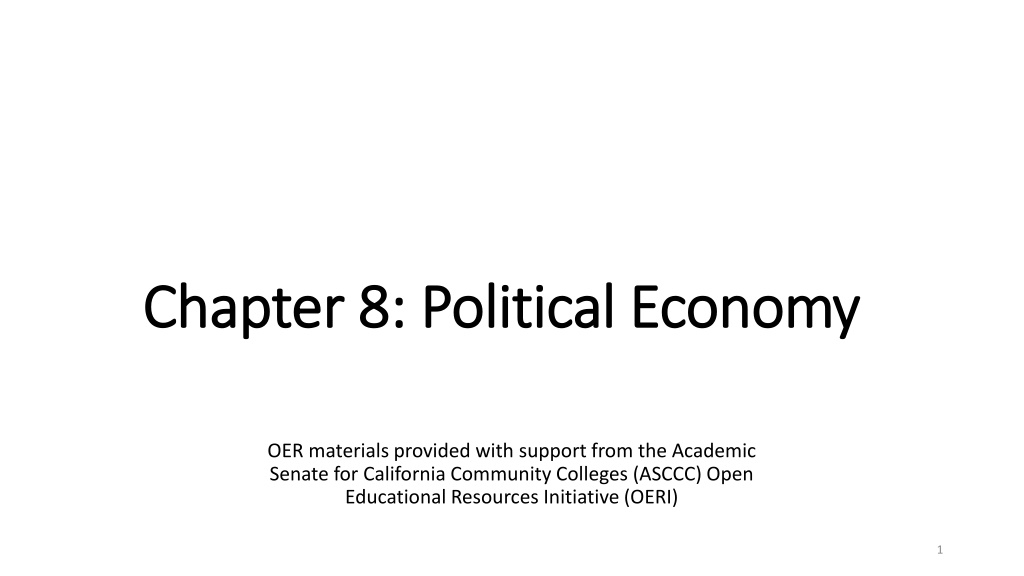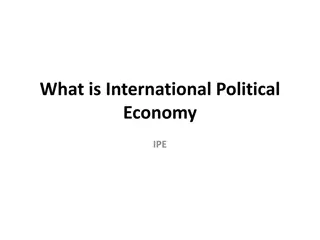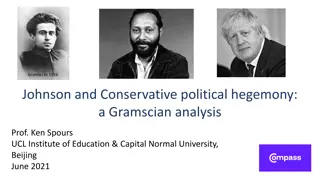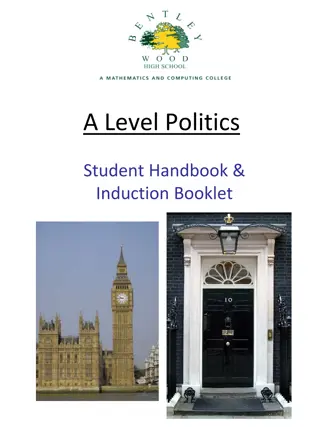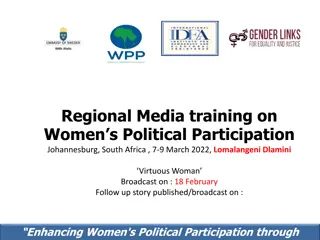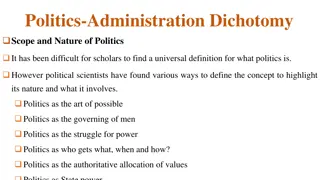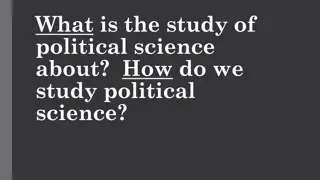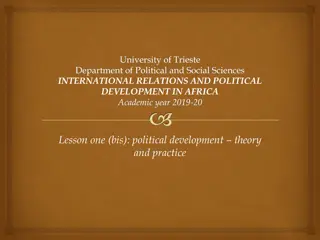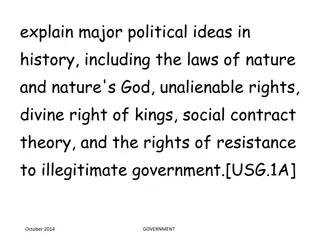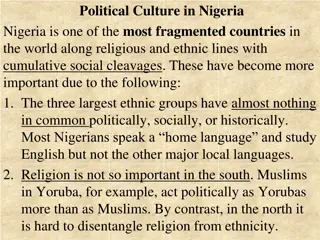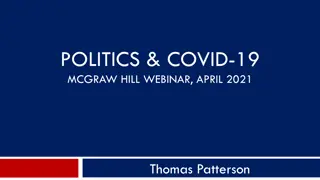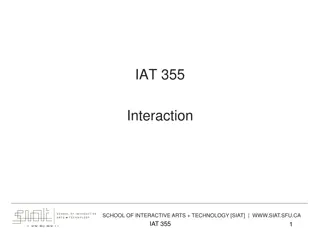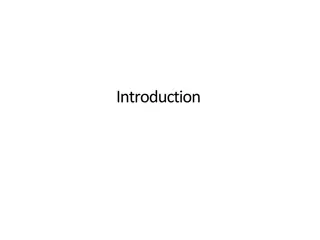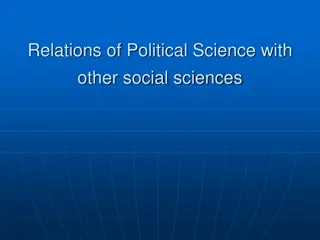Understanding Political Economy: Insights into the Interaction of Politics and Economics
Exploring the realm of political economy through the lens of interactions between political and economic goals and policies. Delve into the historical background, contemporary perspectives, and comparative case studies to gain a deeper understanding of this dynamic field. Discover the relevance of political economy in shaping domestic and international policies, and its impact on key issues like trade, taxation, and regulation.
Download Presentation

Please find below an Image/Link to download the presentation.
The content on the website is provided AS IS for your information and personal use only. It may not be sold, licensed, or shared on other websites without obtaining consent from the author. Download presentation by click this link. If you encounter any issues during the download, it is possible that the publisher has removed the file from their server.
E N D
Presentation Transcript
Chapter 8: Political Economy Chapter 8: Political Economy OER materials provided with support from the Academic Senate for California Community Colleges (ASCCC) Open Educational Resources Initiative (OERI) 1
Chapter Outline Chapter Outline Section #8.1: What is Political Economy? Section #8.2: Political Economic Systems Section #8.3: Comparative Case Study: Germany and China 2
Section #8.1: What is Political Economy? Section #8.1: What is Political Economy? 3
What is Political Economy? 1 What is Political Economy? 1 Political Economy: the interaction of and between political and economic goals and policies: Interactions run both ways Because both politics and economics involve human behavior, which is driven by emotion, making predictions is not easy Understanding the influences of each on the other is a core element of providing advice for political leaders, such as in the COVID-19 pandemic 4
What is Political Economy? 2 What is Political Economy? 2 The study of political economy goes back to ancient times, but as a formal discipline it dates to the mid-1700s Adam Smith published The Wealth of Nations in 1776 Trying to study politics and economics separately is more of a 20th Century phenomenon Political economy is studied at both the domestic and international levels Domestic issues include tax policy, regulation of business and monetary policy International political economy [IPE] focuses mainly on trade policy 5
Section #8.2: Political Economic Systems Section #8.2: Political Economic Systems 6
Mercantilism / Economic Nationalism 1 Mercantilism is the oldest of the IPE approaches, but has regained popularity in the 21st Century It is also called economic nationalism because the focus is on preserving and expanding the power of the state Economic nationalists favor protectionist trade policies that give advantage to domestic producers in the competition with foreign producers Tariffs, domestic industry subsidies and favorable tax treatment are some of the common policies 7
Mercantilism / Economic Nationalism 2 A key objective of Mercantilism is to have a diversified economy at home to avoid being dependent on other countries for key resources The main risks of the are: A decline in the quality and an increase in the price of products due to lack of competition If other countries choose the same path, making imports expensive, exporting companies will lose customers and therefore hire fewer workers (Source: Speeches of Year One by Trump White House Archive via flickr is licensed under Public Domain.) 8
Free Market Capitalism / Economic Liberalism 1 Economic liberalism is a newer, though well-established, competing approach to IPE Adam Smith, in The Wealth of Nations, tried to disprove the zero-sum nature of mercantilism The policies of economic liberalism aim to encourage specialization and competition The focus is on the role of individuals and businesses rather than the power of the state 9
Free Market Capitalism / Economic Liberalism 2 Economic liberalism and international trade have been shown to have a positive impact on economic growth However, the benefits of that economic growth are not distributed evenly - some companies and some industries compete more successfully than others in the global marketplace In rich countries, The benefits are often diffuse - felt by consumers buying products The harm is specific and intense - felt by those individuals and communities where they have lost out to international competition 10
Free Market Capitalism / Economic Liberalism 3 Economic liberalism as an IPE model has been closely linked with Modernization Theory Modernization Theory says that as countries modernize their economy - through economic liberalism - they would become more democratic with increased civil liberties Yet, authoritarian states such as China have countered that they can modernize their economy without expanding freedom - these governments point to the inequalities seen in capitalist states as reason to maintain a firm grip on society 11
Marxism / Economic Structuralism 1 Economic Structuralism is rooted in the Marxist approach focusing on protecting the working class [workers] from exploitation by the capital owning class [owners] Modern economic structuralism also focuses on the broader economic structures such as inequality, uneven development, disparate property rights, and the role of specialization and trade - this is different from Economic Nationalism s focus on the state Economic Liberalism s focus on the individual Economic structuralism has been popular in Latin America and other parts of the developing world where many of the dysfunctions and deficiencies of economic liberalism are visible 12
Marxism / Economic Structuralism 2 Economic structuralism [and economic nationalism] rely on tools of protectionism such as tariffs and quotas on foreign goods and subsidies for domestic industry Economic structuralism also tries to fill the void caused by lack of imports with import-substitution, which uses protectionist policies to assist the development of domestic industry Other policies include non tariff barriers, such as financial, physical, and technical barriers One of the challenges is management of the informal economy, where people produce and sell goods and services outside of regular employment 13
Socialism / Social Democracy 1 Socialism, broadly speaking, is both a political and economic system in which property, as well as the means of production, are collectively owned. In most cases, production is owned and controlled by the state. Social democracy, which is defined as a political and economic system that favors heavy market regulation to achieve a more equal society. Democratic socialism, an ideology that seeks democracy not just in the political sphere but in the economic sphere as well. 14
Section #8.6: Comparative Case Study: Section #8.6: Comparative Case Study: Germany and China Germany and China 15
Germanys Social Market Economy Germany s Social Market Economy Full Country Name: Federal Republic of Germany Head(s) of State: President & Chancellor Government: Federal Parliamentary Republic Official Languages: German Economic System: Social Market Economy Location: Central Europe Capital: Berlin Total land size: 137,847 sq. miles Population: 80 million (July 2021 est.) GDP: $4,743 trillion GDP per capita: $53,919 Currency: Euro 16
Chinas Market China s Market- -Oriented, Mixed Economy Oriented, Mixed Economy Full Country Name: People s Republic of China Head(s) of State: President Government: Communist party-led state Official Languages: Standard Chinese Economic System: Market-oriented, mixed economy Location: Asia Capital: Beijing Total land size: 5,963,274.47 sq. miles Population: 1.3 billion (July 2021 est.) GDP: 19.91 trillion GDP per capita: $14,096 Currency: Renminbi 17
8.6 Comparative Case Study: Germany and China Most Different Systems Method Germany and China have different economic structures Germany is a market economy practicing the IPE approach of economic liberalism China uses a blend of economic liberalism and economic nationalism with a significant level of state intervention in the economy Germany and China have similar economic challenges Both are large economies, with China being the 2nd largest and Germany the 5th largest Both face challenge of declining economic growth due to COVID-19 Both are export-based with challenges of balancing domestic political economy pressures with the global market 18
Summary Summary 19
Summary Points Summary Points 1. Political economy is a social science focused on the economic policies within and among states, including the political pressures and influences. 2. Mercantilism / Economic Nationalism seeks to maximize the power of the state through diversification at home and exporting abroad. 3. Free Market Capitalism / Economic Liberalism focuses on individuals and businesses as consumers and producers with an emphasis on competition and specialization. 4. Marxism / Economic Structuralism seeks to protect the working class from exploitation, both at the domestic level and internationally by focusing on structural imbalances. 5. Germany and China share the independent variable of large, export-driven economies. The variables that differ include: type of government and IPE approaches. 20
